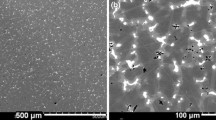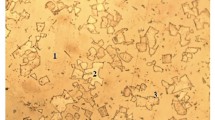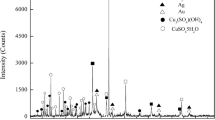Abstract
The paper reports spontaneous and electrochemical dissolution of polymetallic alloy obtained from electrowaste. Effectiveness of chloride, carbonate and sulfate ammoniacal solutions was compared. Leaching process was conducted with and without addition of cupric ions. It resulted in the transfer of primarily copper (over 90%) and negligible amounts of zinc, lead, nickel and iron to the electrolyte, but the rate of the spontaneous dissolution was low. The best condition of the alloy leaching was obtained in the presence of Cu2+ ions in ammonium-carbonate solution. Anodic dissolution of the alloy led to unfavorable distribution of metals among the slime, electrolyte and cathodic deposit, but the highest dissolution rate in the chloride bath was found. Copper can be selectively recovered on the cathode from all electrolytes.








Similar content being viewed by others
REFERENCES
http://www.nies.go.jp/lifespan/.
Crowe, M., Elser, A., Gopfert, B., Mertins, L., Meyer, T., Schmid, J., Spillner, A., and Strobel, R., Waste from Electric and Electronic Equipment (WEEE)—Quantities, Dangerous Substances and Treatment Methods, Copenhagen: EEA, 2002.
Savage, M., Implementation of Waste Electric and Electronic Equipment Directive in EU 25, Inst. Prosp. Technol. Stud., 2006.
Zeng, X., Gong, R., Chen, W-Q., and Li, J., Uncovering the Recycling Potential of “New” WEEE in China, Environ. Sci. Technol., 2016, vol. 50, no. 3, pp. 1347–1358.
Huisman, J., Botezatu, I., Herreras, L., Liddane, M., Hintsa, J., Luda di Cortemiglia, V., Leroy, P., Vermeersch, E., Mohanty, S., van den Brink, S., Ghenciu, B., Dimitrova, D., Nash, E., Shryane, T., Wieting, M., Kehoe, J., Baldé, C.P., Magalini, F., Zanasi, A.,Ruini, F., and Bonzio, A., Countering WEEE Illegal Trade (CWIT) Summary Report, Market Assessment, Legal Analysis, Crime Analysis and Recommendations Roadmap, Lyon, 2015.
Raport o Funkcjonowaniu Systemu Gospodarki Zużytym Sprzętem Elektrycznym i Elektronicznym w 2014 Roku, Warszawa: GIOŚ, 2015 (in Polish).
Fundeko, Korbel and Krok-Baściuk, Sp.J., Standardy Przetwarzania Poszczególnych Rodzajów Zużytego Sprzętu Oraz Wymagania dla Zakładów Przetwarzania Zużytego Sprzętu, Warszawa, 2015 (in Polish).
Nakamura T., Halada K., Urban Mining Systems, Springer Briefs Appl. Sci. Technol., 2015.
Cui, J. and Zhang, I., Metallurgical recovery of metals from electronic waste: A review, J. Hazard. Mater., 2008, vol. 158, pp. 228–256.
Khaliq, A., Rhamdhani, M.A., Brookes, G., and Masood S., Metal extraction processes for electronic waste and existing industrial routes: a review and Australian perspective, Resources, 2014, vol. 3, pp. 152–179.
Willner, J. and Fornalczyk, A., Extraction of metals from electronic waste by bacterial leaching, Environ. Protect. Eng., 2013, vol. 39, no. 1, pp. 197–208.
Pant, D., Joshi, D., Upreti, M.K., and Kotnala, R.K., Chemical and biological extraction of metals present in E-waste: a hybrid technology, Waste. Manage., 2012, vol. 32, pp. 979–990.
Oishi, T., Koyama, K., Alam, S., Tanaka, M., and Lee, J.-C., Recovery of high purity cathode from printed circuit boards using ammoniacal sulfate or chloride solutions, Hydrometallurgy, 2007, vol. 89, pp. 82–88.
Tripathi, A., Kumar, M., Sau, D.C., Agrawal, A., Chakravarty, S., and Mankhand, T.R., Leaching of gold from waste mobile phone printed circuit boards with ammonium thiosulphate, Int. J. Metall. Eng., 2012, vol. 1, no. 2, pp. 17–21.
Lim, Y., Kwon, O., Lee, J., and Yoo, K., The ammonia leaching of alloy produced from waste printed circuit boards smelting process, Geosyst. Eng., 2013, vol. 16, no. 3, pp. 216–224.
Rudnik, E. and Bayaraa, E., Electrochemical dissolution of smelted low-grade electronic scraps in acid sulfate-chloride solutions, Hydrometallurgy, 2016, vol. 159, pp. 110–119.
Rudnik, E., Kołczyk, K., and Kutyła, D., Comparative studies on the hydrometallurgical treatment of smelted low-grade electronic scraps for selective copper recovery, Trans. Nonferr. Met. Soc. China, 2015, vol. 25, no. 8, pp. 2763–2771.
Rudnik, E. and Dashbold, N., Studies on copper recovery from smelted low-grade e-scrap using hydrometallurgical methods, Min. Metall. Proc., 2017, vol. 34, no. 1, pp. 20–29.
Chou, C. and Chen, S., Phase equilibria of the Sn–Zn–Cu ternary system, Acta Mater., 2006, vol. 54, pp. 2393–2400.
Chen, S.-W., Wang, C.-H., Lin, S.-K., and Chiu, C.-N., Phase diagrams of Pb-free solders and their related material systems, J. Mater. Sci.: Mater. Electron., 2007, vol. 18, pp. 19–37.
Groot, D.R. and van der Linde, J.A.N., The processing of e-waste. Part 1: the preparation and characterization of a metallic alloy derived from the smelting of printed circuit boards, J. South. Afric. Inst. Min. Metall., 2009, vol. 109, pp. 697–700.
Cayumil, R., Khanna, R., Ikram-Ul-Haq, M., and Rajarao, R., Hill, A., and Sahajwalla, V., Generation of copper rich metallic phases from waste printed circuit boards, Waste Manage., 2014, vol. 34, no. 10, pp. 1783–1792.
Massalski, T.B., Binary alloy phase diagrams, Metals Park, OH: Amer. Soc. Met., 1990.
The IUPAC Stability Constants Database, Academic Software, UK.
Rajasekharan Nair, K.V. and Namboodhiri, T.K.G., Influence of sulphate and chloride ions on corrosion of 63–37 brass in aqueous ammonia containing copper, Br. Corros. J., 1988, vol. 32, no. 4, pp. 245–249.
Sędzimir, J. and Bujańska, M., The corrosion of copper in copper(II)-ammonium sulphate solutions: the influences of ammonia concentration, of temperature and of the substitution of sulphates by carbonates, Corros. Sci., 1980, vol. 20, nos. 8–9, pp. 1029–1040.
ACKNOWLEDGMENTS
This research work was supported by The National Centre for Research and Development (Poland) under grant no. INNOTECH-2/IN2/18/181960/NCBR.
Author information
Authors and Affiliations
Corresponding author
Additional information
The article is published in the original.
About this article
Cite this article
Ewa Rudnik, Dobosz, I. & Włoch, G. Ammoniacal Dissolution of Polymetallic Alloy Produced from Waste Electroscrap. Russ. J. Non-ferrous Metals 59, 476–485 (2018). https://doi.org/10.3103/S1067821218050152
Received:
Published:
Issue Date:
DOI: https://doi.org/10.3103/S1067821218050152




